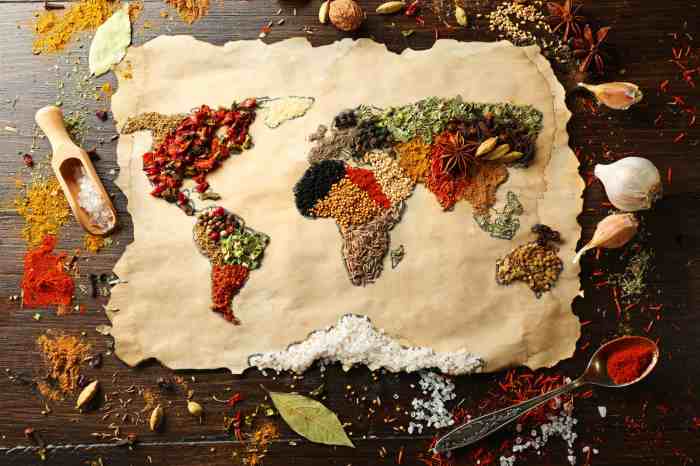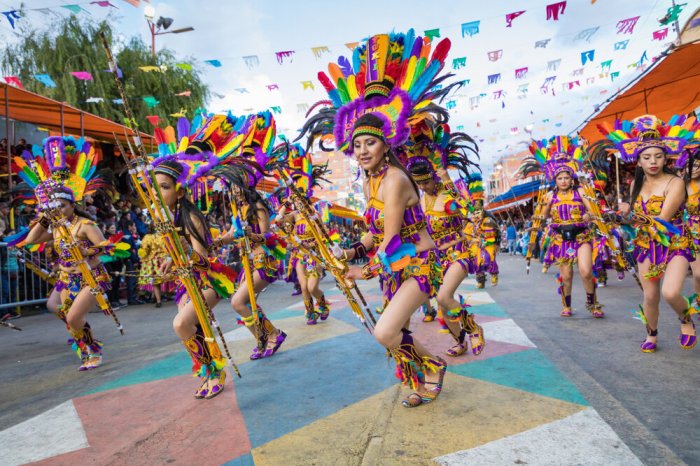
Gourmet Food Festivals Around the World offer a delectable journey for culinary enthusiasts. From the bustling streets of Tokyo to the charming villages of Tuscany, these festivals showcase the world’s diverse gastronomic landscapes. This exploration delves into the top festivals, regional trends, the business behind these events, and the unique travel experiences they offer, providing a comprehensive overview of this vibrant global phenomenon.
We’ll examine the economic impact of these festivals, the sustainability efforts incorporated by organizers, and the luxurious travel options available to those seeking a truly unforgettable experience. Whether you’re a seasoned foodie or a curious traveler, this exploration promises to tantalize your taste buds and ignite your wanderlust.
Regional Gourmet Food Festival Trends

Gourmet food festivals are experiencing a global surge in popularity, reflecting a growing interest in culinary experiences and cultural exchange. These events are no longer simply showcases of food; they are evolving into dynamic platforms that reflect regional trends, economic impacts, and growing concerns about sustainability. The following sections will explore the emerging trends shaping these festivals across different regions.
The globalization of food and the rise of social media have significantly impacted the way gourmet food festivals are planned and experienced. This has led to a fascinating diversification of culinary offerings and an increased focus on both the economic and environmental aspects of the food industry.
Emerging Trends in Gourmet Food Festivals by Region
Different regions are exhibiting unique trends in their gourmet food festivals, reflecting local culinary traditions and broader societal shifts. These trends highlight the dynamism and adaptability of the food festival landscape.
- Asia: A strong emphasis on hyper-local ingredients and traditional cooking techniques, combined with a rise in fusion cuisine events blending regional specialties. Many festivals incorporate interactive workshops and demonstrations, fostering a deeper understanding of culinary heritage. The growing popularity of vegan and vegetarian options also reflects broader dietary shifts.
- Europe: A continued focus on high-quality, seasonal ingredients sourced from nearby farms and producers, emphasizing farm-to-table concepts. Many festivals incorporate wine and spirits pairings, highlighting regional beverages. There’s also a noticeable increase in festivals dedicated to specific food products, like cheese or olive oil, celebrating regional specialties.
- North America: A blend of established and emerging culinary trends, including a growing focus on sustainability, ethical sourcing, and reducing food waste. Street food festivals continue to thrive, showcasing diverse cuisines and affordable options. There’s also a notable rise in festivals emphasizing specific dietary needs, such as gluten-free or allergy-friendly options.
- South America: A celebration of diverse indigenous ingredients and cooking methods, showcasing the unique culinary heritage of the continent. Many festivals are integrating cultural performances and artistic expressions, creating immersive experiences. The emphasis on fresh, vibrant flavors and unique presentations is a defining characteristic.
Examples of Festivals and Their Economic Impact
Numerous festivals around the world directly contribute to local economies by attracting tourists, boosting local businesses, and creating employment opportunities. The following examples illustrate this positive economic impact.
- Taste of Chicago (North America): This large-scale festival attracts millions of visitors annually, generating significant revenue for restaurants, vendors, and the city itself. It showcases Chicago’s diverse culinary scene and boosts tourism.
- Madrid Fusión (Europe): This internationally renowned festival brings together top chefs and culinary professionals, attracting significant media attention and fostering collaborations that benefit the Spanish food industry.
- World Street Food Congress (Asia): This event promotes street food culture and supports small food businesses from across the globe, generating revenue and exposure for participating vendors.
Sustainability and Ethical Sourcing in Gourmet Food Festivals
Growing environmental awareness is influencing the way gourmet food festivals are organized. Many organizers are actively incorporating sustainable practices and ethical sourcing to minimize their environmental footprint and support responsible food production.
- Reduced waste initiatives: Many festivals are adopting compostable tableware, reducing single-use plastics, and implementing efficient waste management systems.
- Sourcing from local and sustainable farms: A growing number of festivals prioritize sourcing ingredients from local farms that employ sustainable agricultural practices.
- Educational programs: Some festivals incorporate educational components to raise awareness about sustainable food systems and ethical sourcing.
- Carbon offsetting: Some larger festivals are exploring carbon offsetting initiatives to compensate for their environmental impact.
The Business of Gourmet Food Festivals

Gourmet food festivals represent a significant economic engine, impacting host cities and regions in multifaceted ways. Their success hinges on a complex interplay of stakeholders, strategic marketing, and the ability to generate substantial revenue and tourism. Understanding the business model behind these events is crucial for both organizers and those seeking to capitalize on their economic potential.
Economic Impact of Gourmet Food Festivals
Major gourmet food festivals generate substantial revenue through various channels, including ticket sales, vendor fees, sponsorship deals, and ancillary activities like cooking classes or demonstrations. This revenue then trickles down, stimulating the local economy. The tourism impact is equally significant, as these festivals attract visitors from far and wide, boosting hotel occupancy, restaurant patronage, and local transportation services.
Furthermore, these events create numerous temporary and permanent jobs, from event staff and vendors to hospitality workers and transportation providers. The following table provides a hypothetical illustration of the economic impact of a large-scale festival:
| Economic Factor | Estimated Value (USD) |
|---|---|
| Direct Revenue (Ticket Sales, Vendor Fees) | $1,500,000 |
| Indirect Revenue (Hotel Stays, Restaurant Spending) | $2,000,000 |
| Sponsorship Revenue | $500,000 |
| Tourism Impact (Visitor Spending) | $3,000,000 |
| Job Creation (Temporary & Permanent) | 500+ jobs |
*Note: These figures are hypothetical and would vary significantly depending on the scale and location of the festival.* For example, a smaller, regional festival might generate significantly less revenue and create fewer jobs compared to a large international event like Taste of Chicago or the Food Network South Beach Wine & Food Festival.
Stakeholders Involved in Gourmet Food Festivals
The successful execution of a gourmet food festival requires the collaboration of a diverse range of stakeholders. Each group plays a vital role in the festival’s planning, execution, and overall success.
- Sponsors: Corporations and organizations provide financial support in exchange for branding opportunities and visibility. Examples include food and beverage companies, tourism boards, and local businesses.
- Vendors: Restaurants, food trucks, and artisan food producers sell their products directly to consumers, forming the core of the festival’s culinary offerings. Their participation is essential for creating a diverse and appealing culinary experience.
- Local Government: Municipal authorities provide crucial logistical support, including permits, infrastructure, and public safety measures. Their involvement is crucial for ensuring the smooth and safe operation of the event.
- Event Organizers: A dedicated team manages all aspects of the festival, from planning and logistics to marketing and execution. Their expertise is vital for ensuring the event’s overall success.
- Attendees: The ultimate consumers, their participation is fundamental to the festival’s economic success and overall atmosphere. Their presence justifies the event’s existence and drives revenue generation.
Hypothetical Marketing Plan for a New Gourmet Food Festival
A successful marketing plan for a new gourmet food festival would focus on building brand awareness, attracting attendees, and securing sponsorships.
- Target Audience Identification: Defining the specific demographic and psychographic characteristics of the desired attendees is paramount. This allows for targeted marketing campaigns tailored to their interests and preferences.
- Social Media Marketing: Leveraging platforms like Instagram, Facebook, and TikTok to showcase visually appealing content, including food photography, behind-the-scenes glimpses, and influencer collaborations, is crucial for building excitement and generating buzz.
- Public Relations: Securing media coverage through press releases, partnerships with food bloggers and journalists, and collaborations with local media outlets can significantly increase brand awareness and attract attendees.
- Sponsorship Packages: Offering a range of sponsorship packages tailored to different budgets and objectives, providing clear value propositions and showcasing the benefits of sponsorship, is essential for securing financial support.
- Early Bird Tickets and Discounts: Incentivizing early registration through discounted tickets and exclusive offers can boost sales and create a sense of urgency.
- Partnerships with Local Businesses: Collaborating with hotels, restaurants, and transportation providers to offer package deals and create a synergistic experience can further enhance the overall appeal of the festival.
Gourmet Food Festival Experiences
Attending gourmet food festivals is more than just eating delicious food; it’s an immersive sensory journey that awakens the palate and invigorates the soul. The vibrant atmosphere, the tantalizing aromas, and the sheer diversity of culinary offerings create an unforgettable experience for any food enthusiast. This section explores the unique aspects of these festivals from a traveler’s perspective, highlighting the sensory details and the overall impact of attending both large and small-scale events.
Sensory Immersion at Gourmet Food Festivals, Gourmet Food Festivals Around the World
My first experience at a gourmet food festival was the Taste of Chicago. The sheer scale was overwhelming – a sprawling park filled with hundreds of food stalls, each vying for attention with their unique culinary creations. The air thrummed with a cacophony of sounds: the sizzle of grilling meats, the cheerful chatter of attendees, the rhythmic clinking of cutlery.
My senses were bombarded with a kaleidoscope of sights: vibrant colors of exotic fruits and vegetables, the glistening sheen of perfectly seared scallops, the artful presentation of miniature desserts. The smells were perhaps the most captivating – a heady mix of smoky barbeque, fragrant spices, and the sweet aroma of freshly baked pastries. One particular memory stands out: biting into a perfectly crisp, golden-brown churro, its sugary coating melting on my tongue, the warmth spreading through me – a simple pleasure amplified by the festive atmosphere.
In contrast, a smaller, more intimate festival in Tuscany offered a more refined sensory experience. The focus was on the quality of ingredients and the craftsmanship of the dishes. The pace was slower, the conversations more intimate, and the overall atmosphere more relaxed. The smells were more subtle, focusing on the earthy notes of fresh herbs and the rich aroma of truffle oil.
Each bite was a mindful experience, a conscious appreciation of the ingredients and the culinary artistry.
A Foodie’s Travel Itinerary: Three Gourmet Food Festivals
This itinerary focuses on three distinct gourmet food festivals, each offering a unique cultural and culinary experience.
Festival 1: Taste of Chicago (USA)
Dates
Late June/Early July
Accommodation
A centrally located hotel near Millennium Park for easy access to the festival.
Transportation
Public transport (CTA) is readily available.
Focus
Diverse range of American cuisine, representing various regions and culinary styles.
Festival 2: Taste of Tuscany (Italy)
Dates
September/October
Accommodation
A charming agriturismo in the Tuscan countryside, offering a taste of rural Italian life.
Transportation
A rental car provides flexibility to explore the region.
Focus
Authentic Italian cuisine, emphasizing regional specialties and high-quality ingredients.
Festival 3: World Street Food Congress (Singapore)
Dates
December/January
Accommodation
A modern hotel in the heart of Singapore, providing easy access to diverse culinary scenes.
Transportation
Singapore’s efficient public transport system (MRT).
Focus
A global celebration of street food, showcasing culinary traditions from around the world.
Large-Scale vs. Intimate Gourmet Food Festivals: A Comparison
Large-scale festivals, like Taste of Chicago, offer a vast array of choices, a vibrant atmosphere, and a sense of excitement. However, they can also be crowded, noisy, and overwhelming. The focus is often on variety and spectacle rather than intimate culinary experiences. Smaller, more intimate festivals, like the hypothetical Taste of Tuscany, prioritize quality and craftsmanship. They provide a more relaxed and refined atmosphere, allowing for deeper engagement with the food and the culture.
The emphasis is on the quality of ingredients and the culinary artistry, creating a more mindful and personalized experience. While large festivals offer a broader spectrum of options, smaller festivals offer a more focused and immersive experience. The choice depends on the individual’s preferences and priorities.
Ultimately, gourmet food festivals represent more than just culinary celebrations; they are cultural exchanges, economic engines, and unforgettable travel experiences. From the meticulous planning and execution to the passionate participation of attendees and vendors, these events weave a rich tapestry of flavors, traditions, and global connections. The opportunity to savor exceptional cuisine while immersing oneself in different cultures is an invitation to expand one’s palate and broaden one’s perspective, making these festivals truly remarkable events.
Common Queries: Gourmet Food Festivals Around The World
How much do tickets to gourmet food festivals typically cost?
Ticket prices vary widely depending on the festival, location, and type of access (general admission, VIP, etc.). Expect to pay anywhere from a few tens of dollars to several hundred for premium experiences.
Are gourmet food festivals family-friendly?
Many festivals welcome families, but it’s crucial to check the specific event’s policies. Some festivals might have age restrictions for certain activities or areas.
What should I wear to a gourmet food festival?
Comfortable shoes are essential! Dress is generally casual but consider the location and weather. Many attendees opt for stylish yet practical attire.
How can I find out about upcoming gourmet food festivals?
Online searches (using s like “gourmet food festivals [region/country]”), travel blogs, and dedicated foodie websites are excellent resources for discovering upcoming events.


